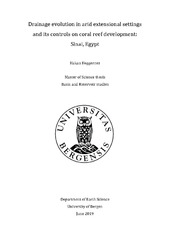Drainage evolution in arid extensional settings and its controls on coral reef development: Sinai, Egypt
Master thesis
Permanent lenke
https://hdl.handle.net/1956/20428Utgivelsesdato
2019-06-26Metadata
Vis full innførselSamlinger
- Master theses [106]
Sammendrag
The Sinai Peninsula is located in a hyper-arid climate environment, which affects drainage, development of coastal fan deltas and the growth of coral reef along the Gulf of Suez and Gulf of Aqaba. The recent extension of Gulf of Suez and the strike-slip tectonics of the Gulf of Aqaba give the possibility to contrast two different tectonic settings under the same arid conditions. The purpose of this study is to identify relationships and trends between catchment areas, fan deltas and coral reefs in the shallow-water area. Additionally two flash flood events, from 2002 and 2016, and the delivery of sediments to the coastal area have been studied. This thesis is based on mapped catchments, fan deltas, coral reefs and shallow-water (to 5 m depth) areas. Mapping of the geomorphological features was done using ArcGIS, where catchments were extracted from a DEM, the fan deltas mapped and shallow-water bathymetry and coral reef area are derived from Landsat satellite images. The drainage systems on the southern Sinai Peninsula are dominated by steep gradients, draining the high mountains of central Sinai. The catchments feed the coastal fan deltas with coarse-grained sediments, which build into the shallow-water areas around the fans, on top of which coral reefs, mostly fringing reefs, colonise. Coastal fans, coral reef and shallow-water areas are larger in the Gulf of Suez due to rotated normal-fault blocks, which are absent in the Gulf of Aqaba. In the study area larger fan deltas have larger areas occupied by coral reefs. The sediments delivered to the coastal areas are delivered by infrequent, aperiodic flash flood events. Such events can be destructive for coral reefs. The fan deltas usually have well-defined distributary channels transporting most of the sediments past the coral reefs and depositing most of it in the area corresponding to 4-5 m water depth. In addition, marine currents quickly remove the sediments deposited by after the flash floods, minimising damage to coral reefs.
